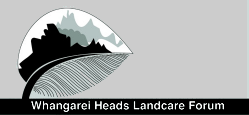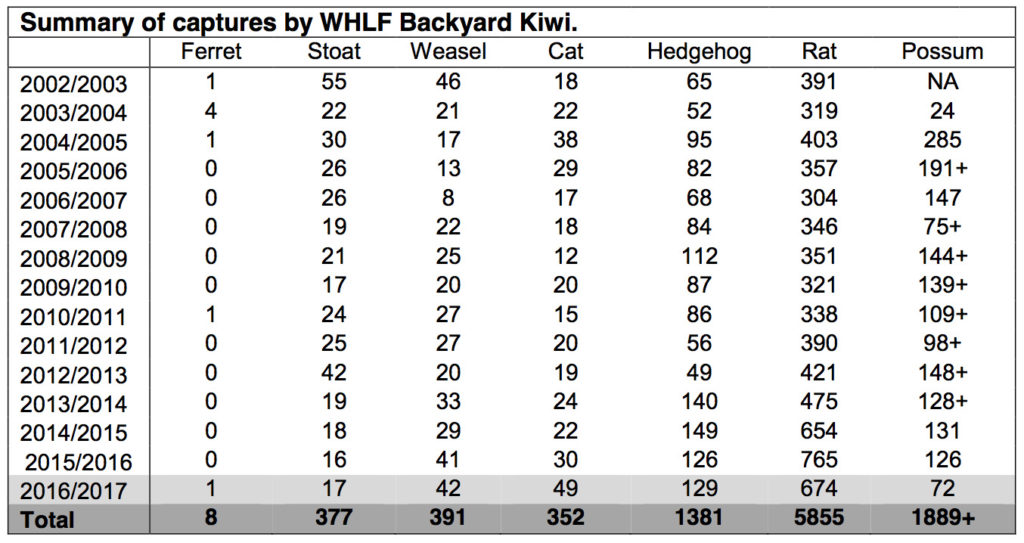Predators such as stoats, dogs and cats are major threats to kiwi populations. The WHLF supports many predator trapping groups around Whangarei Heads as well as providing the platform for Backyard Kiwi to undertake the ‘peninsula wide’ predator trapping program. The WHLF trapping network is complimented by that done on the Manaia and Bream Head reserves by DoC and the Bream Head Conservation Trust.
Trapping Report 2016-17
Trapping Network
Backyard Kiwi operates an effective kiwi predator trapping programme over much of the private land in the Whangarei Heads area to enable kiwi recovery there. Without this predator trapping 95% of kiwi chicks would be killed.
The trapping network has been in place since 2002 with ongoing additions and fine tuning of trap locations continuing since then. As of June 2017 the network includes Mustelid traps: 161 double sets of Mark 6 Fenn traps in plastic tunnels, 129 double Doc 200 sets in boxes, and 21 Doc 250s. Feral cat traps include 31 SA-Coni bears and 34 SA2 feral cat traps.
10 Good Nature A24 self-resetting traps have been trailed since 2011 and proved to be very unreliable and ineffective.
20 new plywood tunnels based on a ZIP (Zero Invasive Predators) design are to be incorporated into the trapping network this season.
Some of the older Doc 200 trap boxes are being modified to incorporate stoat entry holes in the lid.
A professional trapper operates and maintains the trapping network. He also co- ordinates and logistically supports community trappers working on their own land.
The Backyard Kiwi trapping programme complements trapping carried out on the crown land by the Department of Conservation and the Bream Head Conservation Trust (BHCT). Landcare groups such as Kohinui Catchment Landcare, Ross Road LC, Owhiwa Road Landcare, Whareora Landcare, Pataua North Landcare carryout kiwi predator trapping to the north and west of the Backyard Kiwi area. All these groups are part of the wider “Kiwi Coast” initiative which is developing New Zealand’s first kiwi corridor between the Whangarei Heads and the Tutukaka Coast
This landscape wide trapping programme is not only protecting kiwi chicks in the Whangarei Heads area but also the expanding kiwi population in areas north of the peninsula as kiwi move northwards out of the Whangarei Heads kiwi stronghold.
The Whangarei Head’s kiwi population has increased for an estimated 80 kiwi in 2001 to approximately 880 now.
Predators trapped:
Comments on 2016/2017 programme by species:
Ferrets
The very big news is that a ferret was caught in a Fenn trap at Harambee Road, Kauri Mt in November. Ferrets are much larger than stoats and capable of killing adult kiwi. One ferret can have a devastating impact on a kiwi population so it was crucial to catch this animal. The last ferret caught was back in 2010 and prior to that 6 in the period 2002-2004. It shows the importance of our trapping network! Thanks to more landscape trapping in Northland ferret numbers are way down on the bad old days of 15 years ago but we still need to have traps out there capable of catching them (they pull their heads out of Doc 200s).
Stoats
This season was our second lowest ever stoat catch with 17 caught for the year. This compares with 55 in our first year (2002-2003) and an average of 24 stoats in the 12 years 2003 to 2015. Stoat numbers have been significantly reduced in the area by the trapping programme. Stoats are the main cause of kiwi chick deaths in un-trapped areas and are capable of moving long distances to rapidly repopulate an area. To prevent this repopulation the current trapping network needs to be maintained.
Weasels
42 weasel catches in 2016-2017 is the highest tally since 46 were caught in the 2002-2003 season. The average weasel catch for the 13 years between the first knock down year and this season is 23. Interestingly the ratio of stoats:weasels has changed from about 1:1 to over 1:2. The increase in weasels is probably due to the reduction in stoats as stoats prey on the smaller weasels. Weasels have a much smaller home range than stoats so would require a higher density of traps to remove them from the area. This is not justified for kiwi recovery as weasels are too small to prey on kiwi.
Cats
The feral cat catch of 49 is our highest ever and compares with a 14 year average catch of 22. Cat catches have varied from 12 to 49 over that time. Unfortunately people dump unwanted cats in the area and some are left behind after summer holidays at times. The variation in feral cat catches is possibly due to the variation in the number of cats being released each year.
Rats and Possums
Note that the only rat and possum catches shown are the by-catches of the predator trapping programme and that specific possum and rat control undertaken by individual Landcare groups in the WHLF area has accounted for much higher catch numbers of these two pests.
Possible trap/lure shy stoats
Stoats are the main predator for kiwi chicks and trapping networks such as the one at the Whangarei Heads are currently the best method for stoat control. However Department of Conservation work monitoring kiwi chick survival rates at the Whangarei Kiwi sanctuary indicated that over time chick survival rates dropped despite an ongoing long term trapping programme there. This is thought to be due to the generation of a small number of trap shy stoats that survive in the area for a number of years. This emphasises the importance of the attention to detail needed when setting traps including the removal of any old salted rabbit lure from the area completely to minimize the generation of trap or lure shy stoats. Near enough is simply not good enough when it comes to stoat trapping.
DOC trials have shown that by using secondary poisoning it is possible to remove the trap shy stoats. We were fortunate at the Whangarei Heads that DOC carried out a 1080 possum control operation using land based bait-stations at Mt Manaia reserve in 2010.
Because of concern that no future possum control was planned by DOC in the Mt Manaia reserve the WHLF, through Manaia Landcare, initiated a joint effort with DOC, NRC, Ngati Wai Trust Board and the Kiwi Coast that carried out a another controlled pulse of 1080 toxin in the bait station network at Manaia over the winter of 2014. These controlled pulses will have significantly reduced the number of trap shy stoats in the area. Another controlled pulse of 1080 is planned for the spring of 2017.
Previously the use of the toxin Brodifacoum (trade name “Pest Off”) has been avoided by the Landcare groups that are part of the WHLF because of the risk of secondary poisoning of non- target species, such as kiwi. Now in appropriate areas we are using a controlled pulse of Brodifacoum every 2 to 4 years to gain the benefits of secondary poisoning of trap shy stoats from this toxin, while limiting the risk of secondary poisoning to non-target species.
This combination of an extensive trapping network and controlled toxin pulses, is leading to good kiwi chick survival in our area. This is evidenced by the number of wild chicks that have survived to be in excess of 1000g in weight (once a chick is 1000g it is big enough to fight off a stoat) turning up as mates for transmitted adults or dead from road kill. Road kill deaths are unfortunate but are a product of the higher kiwi population.
Previous trapping reports:
15-WHLF Trapping Review
14-WHLF Trapping Report 2013-2014
WHLF Trapping Report 2011-2012
WHLF Trapping Report 2010-2011
WHLF Trapping Report 2009-2010













